

If you care about enjoying your video content in the best quality possible, then you most likely already know that a projector is unbeatable for a truly cinematic experience. However, a great projector is only one piece in a multi-element projection system, as the screen onto which you display makes a world of difference.
Sometimes, after having invested in a top of the line projector, people forego a proper projection screen altogether. Projecting onto a wall or just a white surface has a significant negative impact on image quality. Notably, image contrast, resolution, and color reproduction suffer the most from using a surface not intended for projection.
Actually, we have an entire article dedicated to technological developments that have given us light rejecting surfaces and other advancements that promote superior image quality. Before continuing to read the rest of this article you may want to dive into light resistance and rejection technologies.
But even without specific technologies designed to enhance surfaces, what is it about a projection screen in general that makes it better than just using a readily-available white wall? Moreover, how do you choose the right screen without breaking the bank? Let's discuss the three main aspects of screens: material, size, and style. We’ll then cover how to choose the best one for your room and projector.
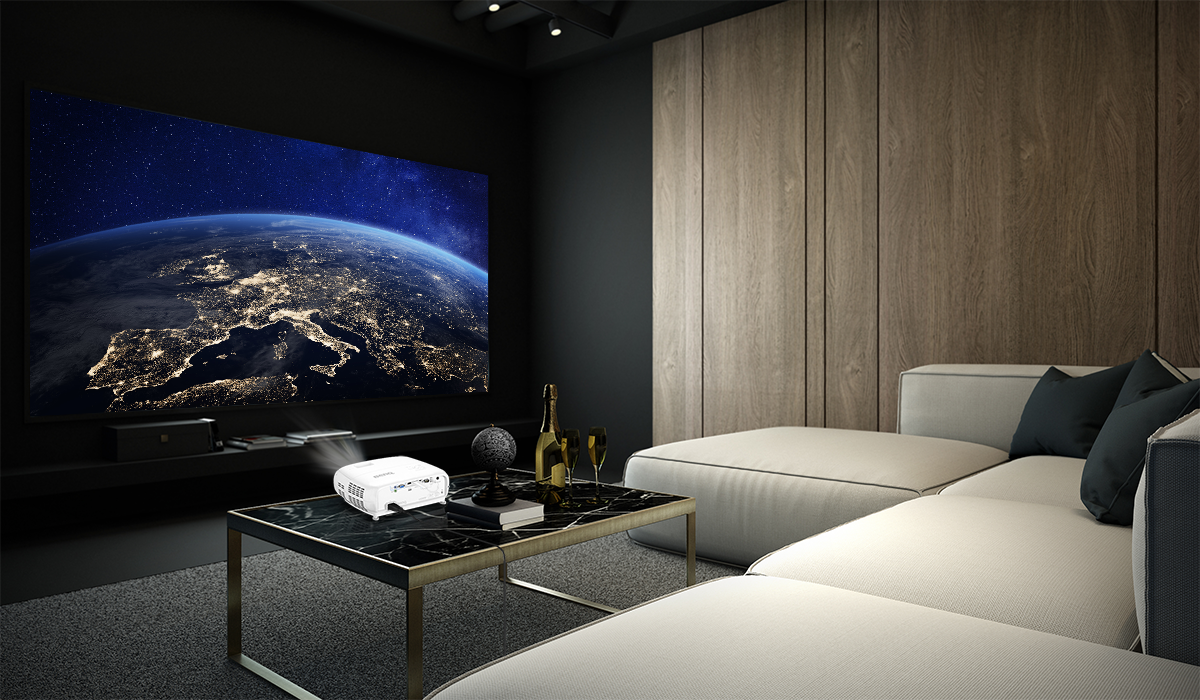
There are two main styles or core designs of screens: fixed and retractable. The one that suits your needs best depends mostly on the room you intend to use for your projector. Also, retractable screens tend to cost more than fixed ones, which might be a crucial factor to keep in mind.
If you have the space available, it is always better to go for a fixed screen. A fixed screen is composed of an aluminum or wooden frame that very tightly holds the screen proper, which in turn is usually made of PVC. This setup offers a very smooth and even projection surface for the lowest price, in part thanks to its simple construction.
Additionally, from an installation point of view, it is easier to integrate. If you can hang a picture frame on a wall, then you already know how to install a fixed frame screen in your media room. Making sure that it is centered and at the right height is enough to have a high quality screen ready for your next viewing session.
The downside to fixed frame screens is their size. To put things into perspective, a 120" diagonal projection screen is approximately 2.65 meters wide. Such a big screen would look out of place in most living rooms, which means that you most likely need a dedicated media room to avoid your projector setup getting in the way of daily life.
If you do not have a dedicated media room, a retractable screen might give you the flexibility needed. This type of screen can be rolled down when you crave some movie enjoyment and then quickly rolled up and out of sight when you’re done. You can place such screens in front of any wall or even your already-there TV.
Retractable screens also give you more ways to integrate the screen into your room in an inconspicuous way, hiding it away until ready to use. They come in two main varieties: pull-up and pull-down. Pull-down screens can be wall or ceiling mounted, allowing you to keep the whole screen away from view in a recessed space in the ceiling. Pull-up screens, on the other hand, are usually placed on the floor behind your media center or integrated into a custom-made piece of furniture, magically popping out for movie time.
Either one of these two types of retractable screens work equally well. However, for any retractable screen, there are two additional aspects you should keep in mind.
The first one is that to obtain the best performance out of a retractable screen, you should look for a tab-tensioned one. This type of screen has a system behind it to ensure that the surface is perfectly tight and flat when pulled out, while the whole tensioning system also moves out of the way when the screen is rolled in. Without tensioning, retractable screens tend to have curling and wrinkling that impact your video experience, creating distortions and image wobbling, most noticeable during panning shots.
The second important aspect is that any of these retractable screens can come in a manual or motorized variety. Manual screens are light, less expensive, and don't need any electricity to work, which makes them easier to install anywhere very quickly. Since there is no risk of a motor failing over time, they represent less maintenance and more years of service. On the downside, you have to get up from your seat and pull these screens out by hand before use, which can seem inconvenient when everything else has a remote control.
Motorized projector screens exist to remedy that inconvenience. They offer the most stylish look for your home theater as they slowly and gracefully emerge from their enclosure for your movie session at the touch of a button. These electric screens can be rolled out by using either a remote control, a wall switch, or by connecting them to the 12V trigger port that is available on many projectors. You have to keep in mind that they require a power supply and also cabling if you decide to use the automatic trigger function. Motorized electric projector screens tend to be the most expensive but also offer the most functionality and flexibility of all types.

A type of screen requiring the user to manually pull the screen down, manual projection screens offer low cost. However, manual screens require readjustment each time they are pulled because the screen position will shift, and the screen can become curled or crimped over time.
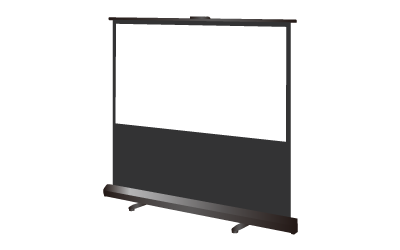
This screen’s operation is different from a manual projection screen. The casing of the screen is placed on the floor and the screen gets pulled up into place. While it is convenient to use without any installation, this type of screen requires more space and is not aesthetically pleasing in a home setting, more suitable for outdoor or office use.
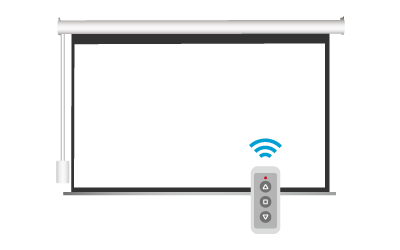
Fixed screens can be set up to hang on a wall like a painting, offering the best flat shape of all the screens listed. These screens blend into surrounding décor for improved aesthetics, and the latest light rejecting screens also feature this type of installation method.
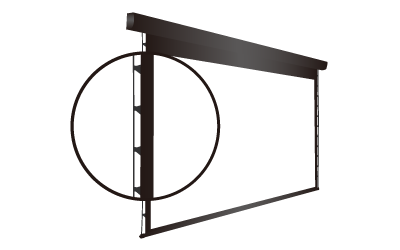
Commonly used in conference rooms and homes, electric screens automatically lower or rise to user-defined stopping points. Similar to manual projection screens, electric screens can become curled or crimped over time.
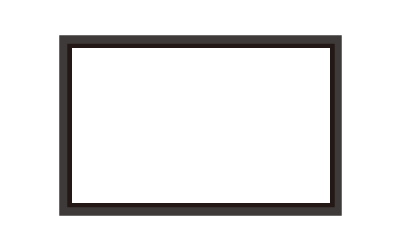
This screen type uses electronic controls and tension cords on both sides of the screen to pull the screen tightly for flatness. While this type of screen prevents curling, it is a more expensive solution.
After deciding the style that suits your media room the best, it's time to choose the right size for your projection screen. While bigger is usually better, the massive size of projector screens presents challenges not commonly found when using TVs that rarely exceed 75" diagonally.
The price difference between a 100" and a 120" projection screen is usually minimal, so you might want to go for the biggest size you can fit on your wall. However, it is advisable to pay attention to a few other factors when choosing an optimal size.
Your room size is the beginning to determine how large screen size can be. Learning the relationship between throw distance and screen size to find out an ideal projector screen size you need: Measure an ideal screen size and distance by projection calculator.
Even if your wall is large enough, bigger is better still may not always prove the best strategy. That is because the bigger the screen is, the longer the distance you need to sit away from it to watch comfortably. If your room is not large enough, you might be better off opting for a smaller screen.
To calculate the optimal viewing distance, we have to consider the field of view of the human eye. SMPTE (Society of Motion Picture and Television Engineers) guidelines recommend sitting at a range where the screen fills up a minimum of 30° of your field of vision, while THX recommends 40° for a more cinematic experience. An easy way to calculate this distance is multiplying the screen size by 1.2 for a cinematic viewing distance or 1.6 for standard usage.
If you use the THX guideline, a 120" projection screen is best viewed from 144 inches or 3.65 meters away while a 100" screen gives you the best experience when viewed from three meters.
Projector screens come in at least three different aspect ratios: 4:3, 16:9, and 2:35:1. Content formatted in 4:3 is standard in older TV shows and almost entirely out of use today, having been replaced by 16:9. However, if you want to feel like you’re at the movie theater, anamorphic 2.35:1 is the best choice.
To choose the ideal aspect ratio for your screen you need to consider the type of video content you watch the most and the formats supported by your projector.
Using a 4:3 screen to watch widescreen content would add black bars to the top and bottom of the image in what is known as letterboxing. Watching anamorphic content on a 16:9 screen would also require these black bars. It's worth mentioning that most TV shows today are 16:9, while most cinematic productions are still shot in 2.35:1.
To use an anamorphic projection screen, you need either a compatible projector or to adjust the projector to make sure that the black bars fall outside the projection area.
More advanced projection systems can automatically change their aspect ratio by using masking, covering parts of the screen dynamically to match the formatting of source content.
To fill in the ultra-wide screen you’re using, you can make use of image zoom so that the black bars fall outside the screen. However, this could compromise image resolution by blowing up unwanted details and may also have a negative effect on brightness. If you want to avoid this, more advanced projectors are compatible with anamorphic lenses that change the image to fit just right on ultra-wide screens.
While we’re discussing how to choose a screen, you obviously should think about the many ways your projector will interact with whatever display you choose. Pay close attention to projector specs, in particular throw distance, brightness, aspect ratio support, and naturally resolution.
One more essential thing to think about is screen material. The link above to new screen technologies sheds a lot of light on this (pun definitely intended), but just remember that screen material has the potential to completely change image properties, so choose carefully.
While the classic projection screen comes in white, you can get surfaces in a variety of colors for different applications. However, since we’re focusing on projection for home entertainment in this article, a white screen would serve you best.
Select screens have added effects applied to them to artificially boost brightness and support supposedly more emphatic HDR. However, this often has the downside of reduced viewing angles and hot spotting, whereby brightness isn’t even and certain parts of the image look unnaturally bright. We recommend neutrally-applied screen coating without a gain boost. With modern HDR-enabled projectors those fixes no longer have any tangible benefit.
Typically, screens utilize a consistent fabric-like material to best block and reflect light. As such, they also block sound and thus require speakers be placed beside them or otherwise elsewhere in the room. Acoustic screens employ a mesh weave that attempts to balance reflectivity with sound transparency, or acoustic passthrough. In simpler terms, these screens try to provide a good image while allowing sound waves to pass through them so that you can save space by placing speakers directly behind the screen. Be advised your experience may vary greatly depending on acoustic screen build quality. To play it safe, we recommend purchasing a conventional fabric display.
A light rejecting screen features special optical technology comprised of embedded black and white linear Fresnel lenses, whose black portions absorb ambient light while white elements reflect projected light directly to the viewer. This optical technology enables light rejecting screens to be used in fully lit indoor settings, creating the clearest and most faithful images of the highest quality.
Ambient Light Rejection screen (ALR) is a screen that selectively reflects light back to the audience, unlike most common screens reflect the incoming light uniformly in all directions. ALR screens This effect is achieved by positioning the projector and screen in such a way that the projector's light is bounced towards the audience while the other ambient light in the room is reflected back in some other direction out of the view of the audience. ALR screens only work if the ambient light is not hitting the screen from the same direction the projector.
Ceiling Light Rejecting® (CLR) is a new version of Ambient Light Rejection screen (ALR). The special material absorbs up to 95% of overhead lighting. Its serriform optical surface lens microstructure negates the washout effect of ambient light especially from overhead sources. This also enables the material to provide contrast levels that are 100 times greater than that of standard matte white projection screens. We recommend to match BenQ's laser projectors with Aeon CLR® Series - Elite Screens Projector Screens (model name: AR100H-CLR, AR120H-CLR) .
Don’t worry, while there’s a lot to keep in mind when choosing a screen to pair with your projector, it’s meant to make sure you get years of viewing enjoyment. It’s not a chore if it makes you happy, so have fun setting up your new home media space. And our projector knowledge center has tons more tips to peruse – head on over to check it out.
{{title}}
We will notify you when we have more.
We will send you an email once the product become available.Your email will not be shared with anyone else.
Sorry, our store is currently down for maintenance.We should be back shortly. Thank you for your patience!